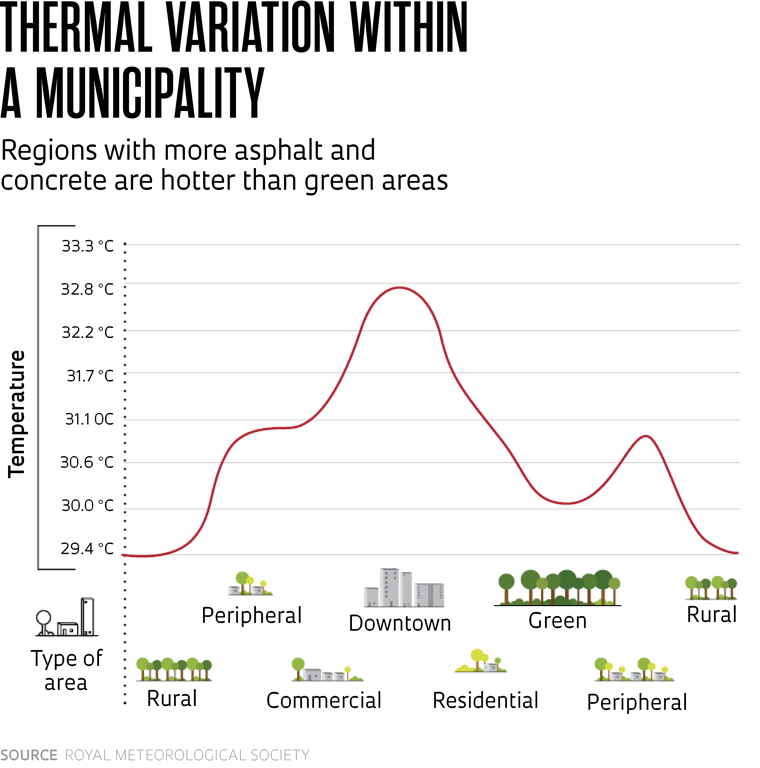Greenhouse gas emissions are the primary reason why Earth’s climate has been getting progressively warmer since the mid-nineteenth century. Since the beginning of the Second Industrial Revolution, the planet’s average temperature has risen by around 1.1 degrees Celsius (ºC). At a local level, the urban setting currently inhabited by most of the global population intensifies the extra heat created by climate change. According to estimates by the United Nations (UN), more people have lived in towns and cities than in the countryside since 2007, a land occupation dynamic that has likely never occurred before in the history of humanity. More than 55% of the planet’s 8 billion inhabitants now live in urban areas. In many countries the percentage is much higher, and in Brazil it is 88%.
— July was the hottest month in recent history and broke temperature records
— Temperature variations may cause five million deaths per year
With fewer green areas, more concrete and asphalt, and generally disordered land use, cities retain more heat than rural areas. Within these urban environments, areas with fewer trees and vegetation get even hotter, forming what have been dubbed urban heat islands. Until a few years ago, the phenomenon was most noticed and studied in large cities with millions of inhabitants, such as São Paulo, Rio de Janeiro, and other large metropolises. Now, heat islands occur in towns and cities of any size, from the smallest to the largest. The temperature difference between a tree-lined neighborhood and another where the ground is completely impermeable regularly reaches 5 ºC, with peak disparities of 10 ºC at certain times of day.
Together with colleagues from around Brazil, Margarete Cristiane de Costa Trindade Amorim of São Paulo State University (UNESP) has been studying heat islands in small and medium-sized Brazilian cities, such as Florianópolis (half a million residents), Sinop in Mato Grosso (200,000 inhabitants), and Rancharia in São Paulo (30,000 residents). “Although small and medium-sized towns have less pollution and much fewer people crammed into a small area than metropolises, the impact of heat islands is still alarming,” says Amorim. The longest-term study she has undertaken, funded largely by FAPESP, is a comparison of the effect of heat islands in two medium-sized cities located in different climate zones.
55% of the global population lives in urban areas, which are hotter than rural areas
Presidente Prudente, a city of 230,000 inhabitants in the state of São Paulo that is home to the UNESP campus where the geographer works, was chosen to represent a tropical region. Rennes, a city in western France with 220,000 residents, was used as an example of an urban area with a temperate climate. For nine months, Amorim monitored temperature patterns in different areas of Presidente Prudente, using 26 sensors that measured the temperature every day in 26 different locations, of which 5 were classified as rural and 21 as urban. Colleagues from the University of Rennes did the same in the French city, which has an average rainfall of 600 millimeters per year, half the amount typically seen in western São Paulo.
The power of the heat island effect was roughly double in Presidente Prudente than in Rennes, as shown in an article published by the Brazilian and French colleagues in the journal Urban Climate in July 2021. “From July to August, in our dry season, there can be as much as a 9 or 10 °C difference in nighttime temperatures between an urban area and a rural one in Presidente Prudente,” says Amorim. “In Rennes, the difference rarely exceeds 5 ºC.” Asphalt and concrete absorb more heat than vegetation and take longer to release this thermal energy. As a result, in the most heavily built-up areas, much of the day’s heat is only released late into the night. During the day, the thermal disparity between different areas of Presidente Prudente was around 3 ºC.
One of the factors in the magnitude of the heat island effect is land use in urban areas. In Presidente Prudente’s case, for instance, public housing built on small lots, almost devoid of any exposed soil or vegetation between houses, is a common urban feature in Brazil that exacerbates the heat experienced in Brazilian cities.



